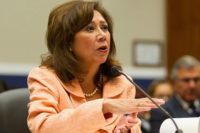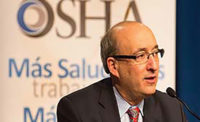 In the spring of 2010, Labor Secretary Hilda Solis, who announced her resignation January 9th, 2013, put her name on the Department of Labor’s Regulatory Agenda Narrative, where she endorsed a strategy of “Plan/Prevent/Protect.”
In the spring of 2010, Labor Secretary Hilda Solis, who announced her resignation January 9th, 2013, put her name on the Department of Labor’s Regulatory Agenda Narrative, where she endorsed a strategy of “Plan/Prevent/Protect.”
In the overview of regulatory actions, Solis said: “The Labor Department seeks to change behavior in these "catch me if you can" operations. Employers and other regulated entities must take responsibility to find and fix problems rather than wait for a Labor Department investigator to inspect, discover the problems, and enforce the law.
“Labor Department enforcement personnel cannot be in every workplace every day, on every shift, in every section of a construction site, factory, or mine, for example. The employer is the first and most important line of defense against violations of the law that threaten workers' safety, health, wages, benefits, equal employment opportunity, and fairness in the workplace.
“The Labor Department's goal is to foster a wide-ranging culture of responsibility and compliance with a focus on prevention. To achieve this goal, a new system is needed to replace ‘catch me if you can.’
That system has become known as I2P2, the Injury and Illness Prevention Plan. I2P2 was the most controversial issue at OSHA in President Obama’s first term.
What's ahead for I2P2?
The question now is, will Solis’s replacement as head of the DOL “have OSHA’s back” to the extent Solis defended and supported the agency?
Solis described the plan in the 2010 spring reg calendar narrative: “Employers and others must "find and fix" violations — that is, assure compliance — before a Labor Department investigator arrives at the workplace. Employers and others in the Department's regulated communities must understand that the burden is on them to obey the law, not on the Labor Department to catch them violating the law. This is the heart of the Labor Department's new strategy.
Specifically, she itemized the strategy’s components:
- "Plan": The Department will propose a requirement that employers and other regulated entities create a plan for identifying and remediating risks of legal violations and other risks to workers — for example, a plan to search their workplaces for safety hazards that might injure or kill workers. The employer or other regulated entity would provide their employees with opportunities to participate in the creation of the plans. In addition, the plans would be made available to workers so they can fully understand them and help to monitor their implementation.
- "Prevent": The Department will propose a requirement that employers and other regulated entities thoroughly and completely implement the plan in a manner that prevents legal violations. The plan cannot be a mere paper process. The employer or other regulated entity cannot draft a plan and then put it on a shelf. The plan must be fully implemented for the employer to comply with the "Plan/Prevent/Protect" compliance strategy.
- "Protect": The Department will propose a requirement that the employer or other regulated entity ensures that the plan's objectives are met on a regular basis. Just any plan will not do. The plan must actually protect workers from violations of their workplace rights.
What will Solis' replacement do?
In DC’s hyper-active world of politics, 2010 is ages ago. And OSHA is nowhere near actually proposing what Solis outlined as the DOL’s central regulatory and enforcement strategy. OSHA’s standards-setting mill ground to a halt in the second half of Obama’s first term in the face of the “regs kill jobs” offensive launched by business groups, and in the face of the 2012 president election reg agencies such as OSHA were forced to tread lightly on anything controversial.
In the coming months it will be worth following if Solis’s replacement changes the DOL game plan, or stays the course. In any event, many DC OSHA-watchers doubt I2P2 will ever become the mandate envisioned by Solis.








.jpg?t=1721257160)

